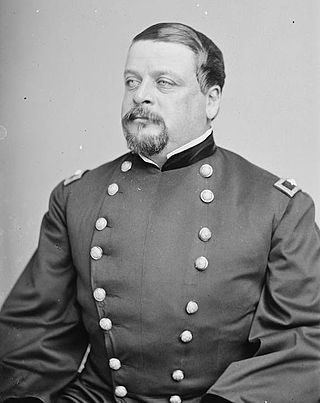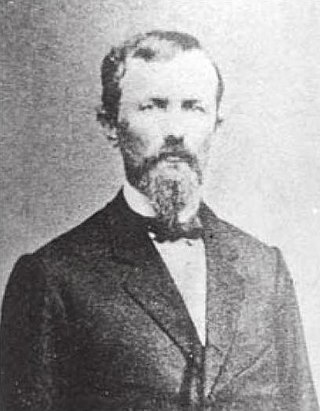
United States Colored Troops (USCT) were Union Army regiments during the American Civil War that primarily comprised African Americans, with soldiers from other ethnic groups also serving in USCT units. Established in response to a demand for more units from Union Army commanders, USCT regiments, which numbered 175 in total by the end of the war in 1865, constituted about one-tenth of the manpower of the army, according to historian Kelly Mezurek, author of For Their Own Cause: The 27th United States Colored Troops. "They served in infantry, artillery, and cavalry." Approximately 20 percent of USCT soldiers were killed in action or died of disease and other causes, a rate about 35 percent higher than that of white Union troops. Numerous USCT soldiers fought with distinction, with 16 receiving the Medal of Honor. The USCT regiments were precursors to the Buffalo Soldier units which fought in the American Indian Wars.

Alfred Gibbs was a career officer in the United States Army who served as an officer during the Mexican-American War and Apache Wars. He served as a brigadier general in the Union Army during the American Civil War.

Benjamin Franklin "Grimes" Davis was an American military officer who served in Indian wars, and then led Union cavalry in the American Civil War before dying in combat. He led a daring escape from the Confederate-encircled Union garrison at Harpers Ferry.

The Iron Brigade, also known as The Black Hats, Black Hat Brigade, Iron Brigade of the West, and originally King's Wisconsin Brigade was an infantry brigade in the Union Army of the Potomac during the American Civil War. Although it fought entirely in the Eastern Theater, it was composed of regiments from three Western states that are now within the region of the Midwest. Noted for its excellent discipline, ferocity in battle, and extraordinarily strong morale, the Iron Brigade suffered 1,131 men killed out of 7,257 total enlistments: the highest percentage of loss suffered by any brigade in the United States Army during the war.

The Queen's Own Yorkshire Dragoons was a yeomanry regiment of the British Army in existence from 1794 to 1956. It was formed as a volunteer cavalry force in 1794 during the French Revolutionary Wars. Its volunteer companies played an active role with the Imperial Yeomanry in the Second Boer War, but opportunities for mounted action were much more restricted during the First World War and it was temporarily converted into a cycle unit. It remained a cavalry regiment throughout the interwar years, and was the last horsed unit of the British Army to see action, in the Syria–Lebanon Campaign of 1941, finally mechanising the following year. It served as motorised infantry in the North African and Italian campaigns of the Second World War. In 1956, it merged with the Yorkshire Hussars and the East Riding of Yorkshire Yeomanry to form the Queen's Own Yorkshire Yeomanry. Its lineage is continued today by A Squadron, the Queen's Own Yeomanry.

The 9th New York Infantry Regiment was an infantry regiment that served in the Union Army during the American Civil War. It was also known as the "Hawkins' Zouaves" or the "New York Zouaves."
The Thirteenth Pennsylvania Reserve Regiment, also known as the 42nd Pennsylvania Volunteer Infantry, the 1st Pennsylvania Rifles, Kane's Rifles, or simply the "Bucktails," was a volunteer infantry regiment that served in the Union Army during the American Civil War. It was a part of the famed Pennsylvania Reserve division in the Army of the Potomac for much of the early and middle parts of the war, and served in the Eastern Theater in a number of important battles, including Antietam, Fredericksburg, and Gettysburg.

The 1st Tennessee Cavalry Regiment was a cavalry regiment that served in the Union Army during the American Civil War. It was also known as 1st East Tennessee Cavalry. The regiment was organized and was nominally commanded by Robert Johnson, the second son of Tennessee politician and Southern Unionist Andrew Johnson, but in truth the regimental commander was James P. Brownlow, the second son of Parson Brownlow.

The 118th New York Infantry Regiment was recruited for service in the American Civil War (1861–1865) from Clinton, Essex, and Warren counties in Northern New York. Known as the Adirondack Regiment, the unit saw service along the Atlantic Coast in the Department of Virginia before transferring to the Army of the James in 1864. With the latter, they were engaged in the Overland Campaign and the subsequent siege of Petersburg.

The 1st New York Dragoons Regiment was a cavalry regiment that served in the Union Army during the American Civil War.
The 19th New York Cavalry Regiment was a cavalry regiment that served in the Union Army during the American Civil War.

The 45th New York Infantry Regiment, also known as the 5th German Rifles, was an infantry regiment that served in the Union Army during the American Civil War. It was composed almost entirely of German immigrants. Formed approximately five months after the start of hostilities, the unit's service spanned almost the entirety of the war, and it saw action in several of the war's noteworthy battles, in both the Eastern and Western Theaters.

The Second Battle of Pocotaligo, or Battle of Pocotaligo Bridge, or Battle of Yemassee, often referred to as simply the Battle of Pocotaligo, took place during the American Civil War on October 22, 1862 near Yemassee, South Carolina.

The 61st New York Infantry Regiment, also known as the "Astor Regiment", was an infantry regiment of the Union Army during the American Civil War.

The 6th Regiment New York Heavy Artillery, U.S. Volunteers, the "Anthony Wayne Guard", was an artillery regiment of the Union Army during the American Civil War. It was originally mustered in as the 135th New York Volunteer Infantry Regiment, and served as both artillery and infantry.

The 80th New York Infantry Regiment, originally designated the 20th New York State Militia Regiment, "Ulster Guard", was an infantry regiment of the Union Army during the American Civil War.

The 83rd New York Infantry Regiment, the "Ninth Militia," "Ninth Infantry National Guard," or "City Guard", was an infantry regiment of the Union Army during the American Civil War.
The First Mississippi Cavalry Regiment was a unit of the Confederate States Army during the American Civil War. Originally designated the First Battalion Mississippi Cavalry, the unit was upgraded to a regiment in 1862, and fought in many battles of the Western theater of the American Civil War.










